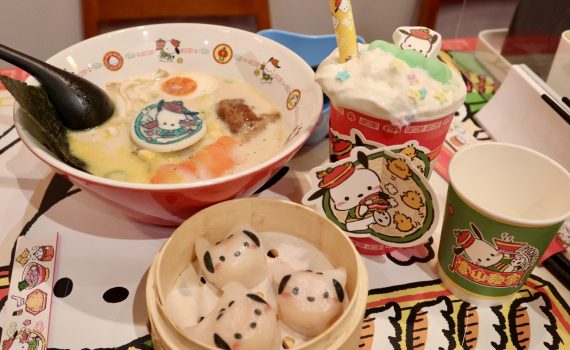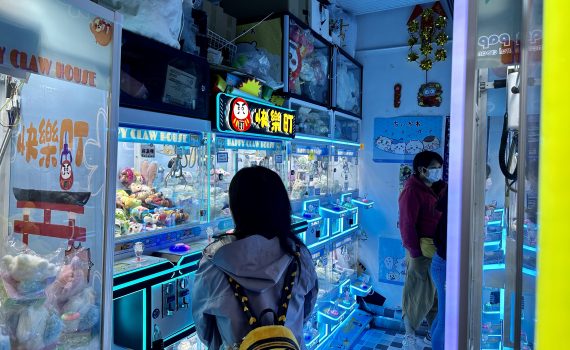Culture & Leisure
Budget 2025: Paul Chan eyes Kai Tak Sports Park to spur tourism
- 2025-02-26
- Society
- The Young Reporter
- By: ZHOU Yun、TANG SiqiEdited by: WANG Jing
- 2025-02-26
Financial Secretary Paul Chan Mo-po proposed in today’s budget speech that has his eyes on Kai Tak Sports Park to spur the tourism industry. “The Government has been supporting the staging of major international sports events in Hong Kong through "M" Mark System. We will adopt a more strategic approach in continuously attracting sports events which can bring significant economic benefits to Hong Kong, and are in discussion with LIV Golf which has been held in Hong Kong for two consecutive years to explore long-term partnership,” he told the Legislative Council this morning. Following the completion of five tests on the venue, including the ticketing system and crowd management, the park is set to officially open in three days. “The park will provide a world class venue for hosting international mega events, taking forward the development of culture, sports and tourism as an industry in Hong Kong,” said Chan. In 2024, 4.5 million visitors came to Hong Kong, an increase of 32.35% from 2023, according to the government figures. “Modern culture, such as sports events and concerts, are important elements in driving tourism today,” said Ervi Liusman, Senior Lecturer of Hotel and Tourism Management at the Chinese University of Hong Kong. The Kai Tak Sports Park has 50,000 seats, which is about four times more than that of the AsiaWorld-Expo. “Some international singers who want to hold concerts in Hong Kong gave up their bids due to venue size restrictions,” Liusman said. “But Kai Tak Sports Park offers a lot more space.” The park is the only venue in Hong Kong that meets the requirements of multiple international events, which can host sports and cultural activities under any weather conditions. Up till now, the park has contacted over 200 local and overseas sports and non-sports event organisers. About 50 companies …
Themed restaurants offer new experiential consumption culture
- 2025-02-24
- Society
- The Young Reporter
- By: ZHOU Yun、LIN XiaoyouEdited by: CAO Jiawen
- 2025-02-24
At Ramen Iroha, a cartoon dog co-branded theme restaurant in Causeway Bay, Iris Lee, 20, takes pictures of the dishes and shares them on Instagram. “I’m a fan of Pochacoo,” Lee said. “I come here not just because the ramen is delicious but to experience being surrounded by lovely Pochacoo.” All the decorations in Ramen Iroha are filled with Pochacco elements, including the food itself. Soon after its launch in December 2024, an Instagram post on Ramen Iroha went viral, attracting long lines of customers. Cyrus Lin, 37, the founder of Ramen Iroha, said during the peak hours, consumers may have to wait in line for up to three hours. “Today’s consumers attach great importance to the experiential value of their purchases and seek emotional engagement and social interaction with brands,” Lin said. “I love Pochacco, I came specifically to check in after reading the promotion on Instagram,” said Donnie Yu, 27, a bank worker. “I will also share my dining experience on social media.” “In an era dominated by social media, I think sharing unique experiences has become an important consumption trend,” Yu added. “Sharing such experiential consumption experiences satisfies my emotional and social needs.” Ramen Iroha is one of many restaurants that have risen in fame in the city in recent months and co-branded with well-known intellectual property images. Since January, co-branded restaurants such as Kingsley Cafe × Snoopy, Black Wood LZAKAYA × Cinnamoroll, and ABURI EN × Attack on Titan have also been launched. “Along with the growth in the number of such restaurants, there is also a growing demand from consumers for immersive experiences in the catering industry,” Lin said. “Space layout, tableware design, dish placement, and even the service style of employees are all details that need to be improved.” Lin said Ramen Iroha will …
Economic downturn fuels claw machine entrepreneurship
- 2025-02-24
- Society
- The Young Reporter
- By: CHENG Tsz Sen Sean、SIU Tsz HangEdited by: Wing Chi HO
- 2025-02-24
Claw machines, once a niche type of amusement, require minimal investment and management to operate, and now they are driving a new wave of entrepreneurship in Hong Kong’s bustling malls amid economic uncertainty. Claw machine arcades can stay open around the clock for which obsessed claw game lovers never have to stop. Recently, these machines have found their way into many shopping malls across Hong Kong, occupying previously vacant shop spaces and offering players a chance to win big prizes, such as a vacuum cleaner or a Nintendo Switch gaming console, for HK$5. The rental index of the Hong Kong retail property market has dropped by over 20 points after peaking in 2019, and the average rent for retail has been decreasing since then, according to the Rating and Valuation Department. Despite the fall, many commercial spaces remain vacant and claw machine arcades have become a short-term solution for both landlords and business starters. Anyone who can afford the rent, the machines and the prizes can open a claw machine arcade, as they require minimal staffing and maintenance. Alan Tang, 30, owner of a claw machine arcade in Yuen Long said all the machines in his shop were rented out in 2020, but only 60% of them are rented out now. His monthly income peaked at nearly HK$100,000 in 2020, but since then Tang has seen a 60% drop in revenue. As of the beginning of this year, machine rent ranges from HK$3,500 to HK$4,500, a 25% decrease from 2020. By comparison, fewer machines are being rented out. “Claw machines require little management, more people are joining this business as it brings a decent amount of profit,” Tang said. Tang added that the monthly rent for his store is about HK$50,000. Operating 24 …
Giant Panda Twin Cubs 100 Days Celebration
- 2025-02-17
- Society
- The Young Reporter
- By: Wing Chi HO、Chun Lim LEUNGEdited by: Sze Kei WONG
- 2025-02-17
Hong Kong's first locally born pandas cubs turned 100 days old on Saturday at Ocean Park, which drew more than 16,000 to its birthday celebrations. Panda twins’ father Le Le also made an appearance for the first time in two months. Reported by : Chun Lim LEUNG、Wing Chi HO Edited by: Sze Kei WONG
Meet Hong Kong-born Giant Panda Twin Cubs
- 2025-02-17
- Society
- The Young Reporter
- By: Wing Chi HO、ALISHIBA MATLOOBEdited by: Chun Lim LEUNG
- 2025-02-17
Giant Panda twin cubs meet the media at Hong Kong Ocean Park ahead of their public debut on Sunday (February 16). Reporter: Wing Chi HO, Alishiba-Matloob Editor: Chun Lim LEUNG
Remade vintage sparks sustainable fashion trend
- 2025-02-17
- Society
- The Young Reporter
- By: LAU Ka Yan、CHAN Hiu YingEdited by: LI Sin Tung
- 2025-02-17
Crowds of shoppers, most of them young, pack into the narrow corridors on the 15th floor of Ho King Commercial Centre in Mong Kok, especially on the weekends and during holidays. They are drawn to the remade vintage clothes and accessories at CheckThis. The owner, Mic Chung, 25, designs the products. “I found some remade items while traveling in Japan and Thailand. At that time, remade vintage clothes or accessories were still not popular in Hong Kong, so I thought it was a potential market I could work for,” she said. Remade vintage is one of the practices of upcycling, where second-hand clothing is collected and different fabrics are patched together to create unique pieces. The emphasis is on sustainability and waste-reduction. In Hong Kong, remade vintage fashion is gaining momentum as young shoppers increasingly seek sustainable alternatives to fast fashion. Stores including CheckThis and Redress offer remade clothing that blends unique designs with environmental consciousness. CheckThis uses Instagram to engage with customers and employs marketing tactics like lucky bags or holiday discounts to attract consumption. “I am glad that the shop has become more and more popular among younger consumers, and I can feel that people are becoming increasingly aware of the need to protect the environment,” Chung said. Chung said vintage is not new, so the products and designs must be relatively rare in order to attract customers. “Compared to the affordability promoted by fast-fashion brands, vintage offers the uniqueness that consumers value more today,” she said. Gary Tsang, a member of the Hong Kong Fashion Designer Association, said that amid the rise of Y2K and Y3K trends, more young customers prefer upcycling or other sustainable alternatives to fast fashion. Y2K fashion responds to novelty with a futuristic retro vibe, focusing on bright colours. Y3K goes further, aiming …
Flowers bloom on Valentine’s Day, but not the sales
- 2025-02-17
- Society
- The Young Reporter
- By: CHAU Wing YauEdited by: ZHANG Yiping
- 2025-02-17
Flowers sales for Valentine’s Day fell short of expectations, as florists at Mong Kong Flower Market reported a decrease in sales compared to last year. With roses, sunflowers and white gypsophila decorating the streets, the Mong Kok Flower Market, a well-known area for buying flowers and plants, was crowded with people on Valentine's Day. However, sales were not ideal for florists. Chris Ng, who is in her thirties and working in a flower shop called “Floralwords”, said that the sales were 30% less than last year. “Only around 80 bouquets have been ordered so far,” said Ng. “The economy is worse right now, so our store did not raise prices for Valentine’s Day.” The price for a bouquet of 20 roses at their store was HK$880. Rex Cheung, who works at Some Flower in Mong Kok, also reported a 30% sales decrease compared with last year. “There were only around 10 customers who bought flowers the day before Valentine’s Day, and the customer flow is even worse on Valentine’s Day,” said Cheung. Cheung agreed with Ng that the decline in flower sales is related to the sluggish performance of the Hong Kong economy. “The economy is poor this year, so cost has become a concern of customers,” he added. Brandon Qin, a 19-year-old secondary student, bought his girlfriend a bouquet in a Mong Kok flower shop. “I bought this for around HK$30, which is a bargain for Valentine’s Day,” said Qin. “But if I have time, I will buy flowers in Shenzhen,” Qin added. “The flowers in Shenzhen are less expensive. Flowers at HK$300 in Hong Kong may only be 200 yuan (HK$215) in Shenzhen, so it is more affordable.” In a bid to increase sales, flower shops came up with various marketing strategies. Some of them made romantic quotes …
Hindu devotees celebrate Thaipusam in Singapore
- 2025-02-16
- People
- The Young Reporter
- By: LIU Yutong、BO ChuxuanEdited by: WANG Ludan
- 2025-02-16
Around 16,000 Hindu devotees carried their Paal Kudam (pots of milk as offerings) or Kavadis (ornate structures that symbolise burden) in Singapore to mark the annual rite of Thaipusam, the sacred Hindu Thanksgiving Festival on Feb. 11. From 11:30 pm on Feb. 10, batches of devotees set off from Sri Srinivasa Perumal Temple and started a 3.2-kilometer barefoot walk to Sri Thendayuthapani Temple, together with friends and relatives chanting hymns and prayers to support them along the way. “Thaipusam is celebrated on the first full moon in the Tamil month of Thai, dedicated to the Hindu god Lord Murugan, who is the deity of courage, power, and virtue," said Edwin Tong, Minister for Culture, Community, and Youth, in his post on Facebook. Karthi Keyan, 24, a chef in an Indian restaurant, pierced his tongue, chest, and back with several rods as part of his Kavadi to express thanks to God. “I carry Kavadi to redeem a vow to god," he said. “I asked God to let me work in Singapore, and he gave it to me last year.” The Kavadi means “burden” in Hindu, elaborate metal structures adorned with spikes or hooks used to pierce the bodies symbolise "sacrifice at every step" and are borne as a vow to Murugan or as an act of gratitude. “When the Kavadi stings, there is pain, and after that, the pain is not known by God’s grace,” Keyan said. “It is very severe, and we have to bear the pain, leaving the burden on God,” he added. To prepare for the Thaipusam, devotees must be spiritually prepared and lead a life of abstinence, including a strict vegetarian diet for at least one month, according to the National Library Board of Singapore. Rajkirren, 31, had vegan meals cooked by his wife for the 21 …
Young cosplayers in Hong Kong turn passion into profit as 'cosplay commissions' provide emotional fulfillment for fans
- 2025-02-12
- Society
- The Young Reporter
- By: WANG LudanEdited by: YANG Haicen
- 2025-02-12
Leslie Cheng, an 18-year-old cosplay enthusiast, transformed into a male anime character from the popular Japanese TV series. She first put in red contact lenses, concealed her long hair under a wig, and slipped height-enhancing insoles into her shoes to make herself 1.77 meters. She was about to go to Mongkok for a date with a woman she had met online less than a month ago. Tonight Cheng will make HK$200. “This is my new side hustle, which we call cosplay commission,” said Cheng.“Through cosplay, we bring characters from anime into reality and go on dates with the character’s female fans.” Cheng is one thousands running cosplayer commission businesses through social media, especially Xiaohongshu and China’s TikTok, which have made their way to Hong Kong. Many young people here say this new job not only brings in extra cash but also a sense of fulfillment for their female clients and themselves. The cosplaying apparel segment dominated the Asia-Pacific role-playing and otaku apparel industry in 2022, valued at US$ 1.5 million, and the segment will likely getting 7.2%, according to market research company Astute Analytica. “I'm happy that more and more people like the service of cos commission,” Cheng said after first posting photos with her clients and receiving many positive comments on Xiaohongshu. A post titled “Daily Life of Maid Rin Matsuoka” on Xiaohongshu has received over 20,000 likes. Some of Rin Matsuoka’s fans asked in the comment section if they could get the poster’s autograph and have an opportunity to date. Rin Matsuoka is a male character from the Japanese sports anime Free!, recognized for his appealing appearance, intelligence, and loyalty to friends, which attracted groups of female fans, according to the Free! Wiki, a character's science fiction website. “I seek a painter to create an anime-style drawing of …
Animal-shaped lanterns light up end of Chinese New Year celebrations
- 2025-02-11
- Society
- The Young Reporter
- By: LAU Ka YanEdited by: LI Sin Tung
- 2025-02-11
A dazzling array of lights and colour lit up the Hong Kong Cultural Centre piazza and foyer on Friday night as the city celebrated the Lantern Festival. This year’s theme was “Chinese Lanterns: An Enduring Heritage,” co-organised by the Leisure and Cultural Services Department (LCSD) and the Intangible Cultural Heritage Office (ICHO). It featured animal-shaped lanterns, including pandas, peacocks, and koi fish, that symbolise prosperity, strength, and good fortune. At 7 pm, a two-person youth group from the Boys’ and Girls’ Club Association of Hong Kong Mei Foo Children and Youth Integrated Services Centre performed classic songs including Jace Chan's “Born to Be Different”, “People Life, Ocean Wild” from Mayday at the installation for around half an hour. “I feel that this year’s Lantern Festival is a combination of traditional and modern cultures,” said Chloe Yang, 29, a primary school teacher from mainland China.“These lanterns present a modern twist on traditional paper-craft skills, and the animal theme is also very appealing to me,” she added “As a tourist, I am glad to see Hong Kong placing so much emphasis on Chinese culture and bringing it to different people with fun and lively animal symbols,” Yang said. Local paper-crafting Master, Mo Cheuk-kei, was invited by ICHO to make one of the lanterns with the theme of “Glittering Fish – Lanterns with Abundant Blessings,” according to the programme details from LCSD. The lanterns designed were based on traditional New Year paintings in which two little lions play with fish on a pond while holding fortune sticks to pray for the New Year. “I come here to watch the wonderful lanterns every Lantern Festival, and this year's vivid animal lanterns that symbolize China were a big surprise,” said Lau Sui San, a 64-year-old retiree. “I am happy that Hong Kong has so many …










